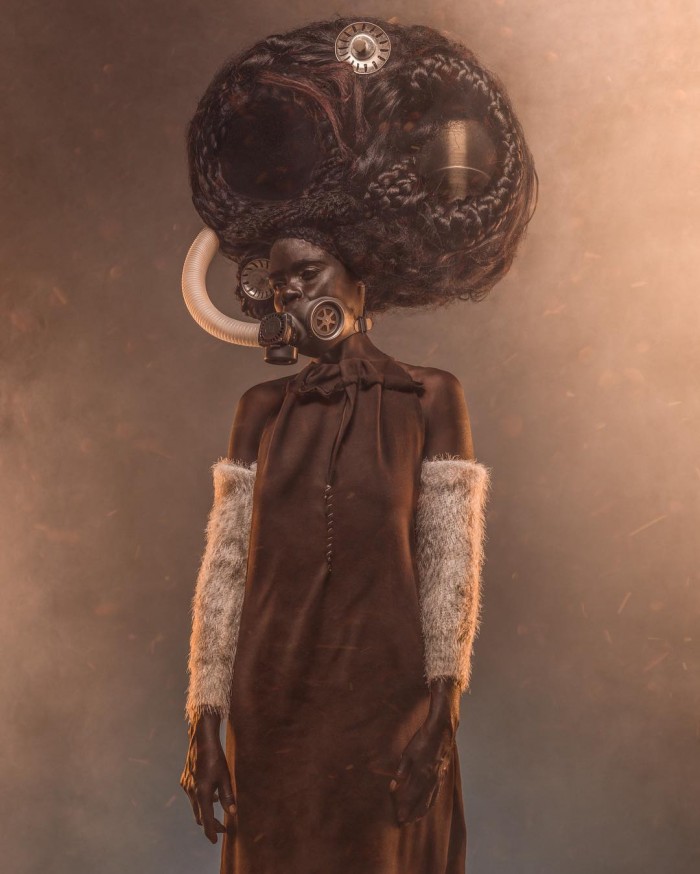With the release of the wildly successful Black Panther feature film at the beginning of this year, the concept of Afrofuturism has really come into its own in mainstream media. Never before in history have we witnessed these strong, black superheroes at the forefront of pop culture.
Beyond the box office, we’re also seeing a proliferation of black narratives in spaces historically reserved for white characters and audiences. We’re seeing Maasai people reimagined in outer space, African space operas, and Kenyan migrant warriors in a galaxy far away.
Why did it take us this long to get here? American scholar Dr Reynaldo Anderson, who is associate professor and chair of the humanities at Harris-Stowe State University, presents a fascinating argument for why Afrofuturism’s opportune moment is now.
From the Kipiriri series by Osborne Macharia
This, the present, is the third historical phase of the movement. Anderson says the first phase was defined by the emergence of cybernetics in the 60s and 70s, the cosmic jazz and philosophy of musician Sun Ra, and perhaps most importantly, the wave of anti-colonial rhetoric and movements across the globe. He calls this phase “futureshock,” a time in which the seeds of modern Black Speculative thought were sown.
The second phase during the late 80s to early 90s was characterised by the mega trend of globalisation, coupled with the emergence of the Internet. It’s only during this stage that the term Afrofuturism was coined by cultural critic Mark Dery to describe the black speculative movement of the time.
Then between 2005 and the present, we find ourselves in the age of acceleration, strongly influenced by the pervasive nature of social media, its ability to shrink the world as we know it, and other societal factors like the financial crisis of 2008 and the surge in visible terror against black bodies. Terror in the form of racial profiling, police brutality and systemic racism, which contributed to movements like #BlackLivesMatter.
He sees Afrofuturism as a way for black bodies to navigate rapid change.
It’s this third phase that brings us to ‘Afrofuturism 2.0: The Rise of Astro-Blackness’ the anthology Anderson co-edited with Charles E. Jones. Where Afrofuturism was something historically explored by the African diaspora, Afrofuturism 2.0 explores its expansion into religion, architecture, communication, social sciences, and particularly so from a Pan African perspective. He says Pan Africanism is itself an idea that originated within the diaspora.
Anderson’s explanation is as revelatory as it is sombre: “Think about it like this. All over the world there are different types of things that have oppressed black people. For instance you have in South Africa the Marikana Massacre, then here the police brutality and Trayvon Martin, when Michael Brown was killed, the Ferguson unrest, a focus on police brutality. The struggling economy kinda brought all things together. Then in Europe we have the wave of fascism against immigrants. These things together all contribute to the emergence of Afrofuturism 2.0.”
By this logic, one can also appreciate that we’ll soon see the emergence of other futurisms too. After all, oppression is not confined to the African experience.
It’s the oppression that gave rise to speculative art forms, and whenever I hear the term, I have to ask: why speculative? Anderson reflects on the power of imagination first to free people from oppression. “We call it speculative because before you actually physically pursue freedom or build a better future you have to imagine it first. It always starts with your imagination. And so the way you imagine freedom or a better life or a future, will start from your imagination first.”
DJ Steloo by Ofoe Amgevie
Together with John Jennings he started the Black Speculative Arts Movement (BSAM), which occurred a result of the ‘Unveiling Visions: Alchemy of The Black Imagination’ exhibition the pair curated. The exhibition would be the beginning of what John Jennings calls critical race design, and to an extent, takes the conversation of Afrofuturism out of its academic confines and into an arts and design context.
Unveiling Visions received submissions from all over the world, and included works by two South African artists, Venus Bambisa and Surreal Xotango. With 87 artists, 20 writers and essayists, the exhibition was organised exclusively via the internet.
Venus Bambisa
BSAM has grown into a network of creatives and intellectuals exploring Afrofuturism, Astro Blackness, Afro-Surrealism, Ethno Gothic, Black Digital Humanities, Black Science Fiction, The Black Fantastic, Magical Realism, and The Esoteric. It‘s the alternative comic con pushing black artists to the forefront. The traveling convention’s most recent iteration took place in Cannes, France, and there’s plans to come to Johannesburg later this year.
As our call concludes, Anderson shares that even though the essence of Afrofuturism has been established in the diaspora, then later retooled for African sensibilities, he has a clear vision for what Afrofuturism 3.0 should be. “It’s up to Africans to take it to the next level. And that could become afrofuturism 3.0,” he says.
If Sunu Gonera’s Design Indaba Conference 2018 talk is anything to go by (and I reckon it is), then we may just be on the brink of it.
More stories on creative forms of Afrofuturism:
Osborne Macharia breathes life into his fantastical, fictional imagery
Steloolive: An experimental, electronic soundscape in Africa









